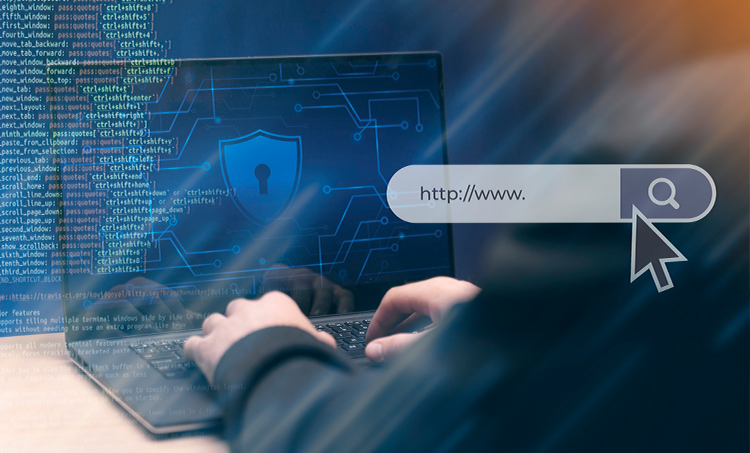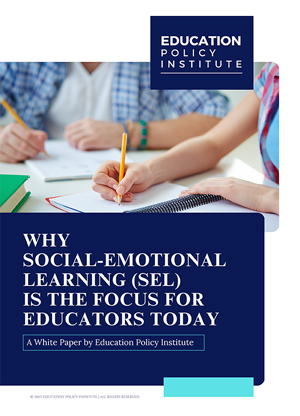As education continues to move toward digital environments, cybersecurity has become a critical concern. With online learning platforms, cloud-based data storage, and internet-connected devices in widespread use, educational institutions are more vulnerable to cyberattacks than ever before. The rise in digital dependency has made safeguarding educational institutions from cyber threats an urgent priority. This article explores why cybersecurity is essential in education, the challenges involved, and strategies to enhance digital safety in classrooms.
Why Do We Need Cybersecurity in Education?
Educational institutions manage vast amounts of sensitive data, including personal details of students and staff, academic records, and financial information. This makes them appealing targets for cybercriminals. In addition, the increased reliance on virtual classrooms, cloud tools, and EdTech platforms has expanded the attack surface.
Children and young students are particularly vulnerable due to their limited awareness of digital risks. If their data is compromised, it could lead to identity theft, privacy invasion, or manipulation. Furthermore, breaches can disrupt learning, cause reputational damage, and impose high financial costs. Therefore, strong cybersecurity measures are necessary not just to protect infrastructure but also to preserve trust, continuity, and student well-being.
Ways to Improve Digital Safety for Students
Protecting students online requires a combination of technology, education, and policy. Here are practical ways to improve digital safety:
- Use Age-Appropriate Tools: Platforms and apps should be selected based on their compliance with privacy standards and suitability for student use. Younger students require simpler interfaces and stronger content filters, while older students benefit from tools that promote responsible usage.
- Implement Access Controls: Limiting student access to approved websites and tools helps reduce exposure to harmful content or potential threats. Access control systems can assign different permissions based on age group or user role, ensuring a safer experience for everyone.
- Regular Security Updates: Keeping all devices and software up to date helps close known vulnerabilities. Educational institutions should have a schedule for patching systems and updating antivirus software to stay ahead of emerging threats.
- Promote Cyber Hygiene: Teaching students about secure passwords, avoiding suspicious links, and reporting cyberbullying can build safer digital habits. Incorporating cybersecurity lessons into the curriculum helps students internalize safety practices.
- Supervised Use of Technology: Monitoring student activity during online learning sessions helps detect any unusual behavior or access attempts. This includes tools that alert teachers when students navigate to inappropriate sites or attempt to share personal information.
Advantages of Cybersecurity in Education
A secure digital environment offers several key benefits:
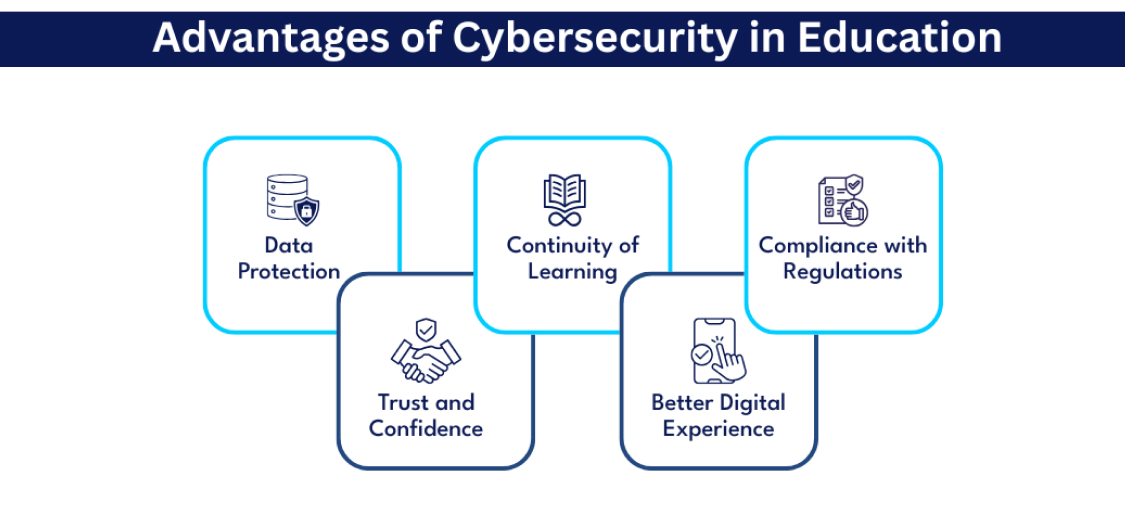
- Data Protection: Strong cybersecurity prevents unauthorized access to student and staff records, ensuring privacy and integrity. Encrypted data storage and controlled access protect sensitive information from leaks and theft.
- Continuity of Learning: Preventing downtime from cyberattacks allows uninterrupted education. Lessons, assessments, and communication can proceed without fear of sudden disruption.
- Trust and Confidence: Parents, teachers, and students feel more secure knowing systems are protected. This confidence encourages participation in digital learning initiatives and remote education.
- Compliance with Regulations: Meeting national and regional data protection standards helps avoid legal issues and penalties. Many education systems are governed by strict data protection laws, and compliance also safeguards institution reputations.
- Better Digital Experience: When systems function securely and efficiently, both teaching and learning become more effective. Fast, uninterrupted access to resources allows for deeper engagement and better academic performance.
The Role of AI in Enhancing EdTech Security
Artificial Intelligence (AI) is playing an increasingly important role in protecting digital classrooms. AI can detect unusual behavior, predict risks, and automate responses faster than human teams.
Key contributions of AI in EdTech security include:
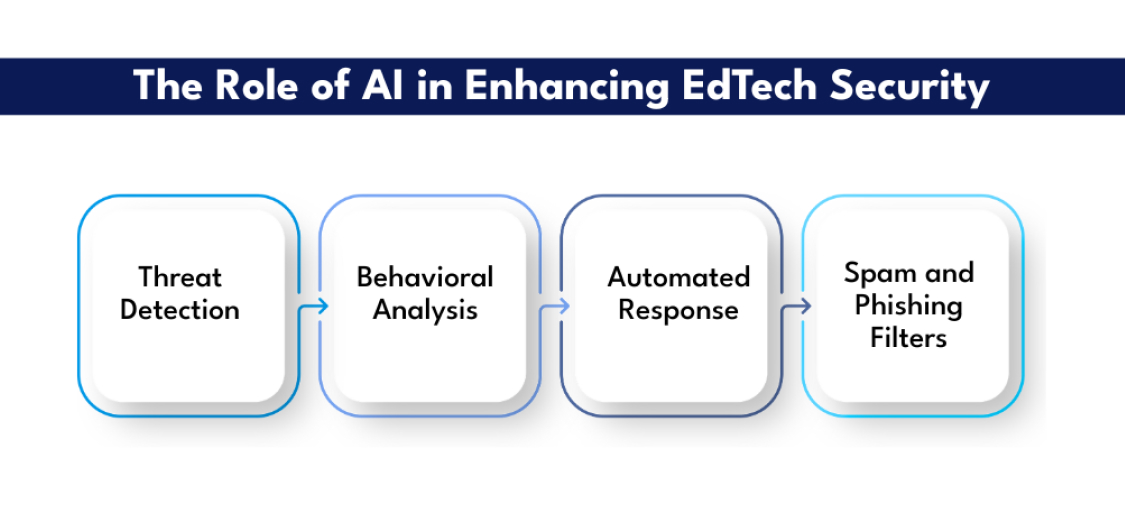
- Threat Detection: AI systems analyze patterns of usage and flag suspicious activity early. This early detection can prevent threats from spreading and becoming more damaging.
- Behavioral Analysis: AI can learn how students and teachers typically interact with platforms and recognize anomalies. Unusual logins, repeated failed access attempts, or abnormal file sharing can be identified in real time.
- Automated Response: In case of an attack, AI tools can block access, isolate infected systems, or alert administrators instantly. This rapid response reduces downtime and protects unaffected users.
- Spam and Phishing Filters: AI helps identify deceptive emails or messages before users engage with them. Email scanning tools powered by AI can flag phishing attempts and dangerous attachments.
AI is not a replacement for human oversight but enhances the efficiency and reach of cybersecurity measures. Its adaptive learning capabilities make it a powerful ally in the evolving threat landscape.
Training and Education for Teachers and Staff
Educators and staff members often serve as the first line of defense against cyber threats. Without proper training, even the most secure systems can be compromised due to human error. Regular and relevant training is essential.
Major topics that must be used for training include:
- Identifying Phishing Emails or Scams: Training should include examples of fake emails and how to verify links or email sources.
- Using Secure Passwords and Managing Credentials: Teachers should learn how to create complex passwords, use password managers, and avoid sharing credentials.
- Understanding Privacy Regulations and Responsibilities: Educators should be familiar with legal expectations around student data and their role in safeguarding it.
- Responding to Suspected Breaches or Security Alerts: Staff must know the steps to take when a breach is suspected—who to inform, how to document the event, and how to prevent further damage.
- Managing Digital Tools Securely During Lessons: This includes safe use of screen sharing, locking digital tests, and limiting app permissions.
Workshops, simulations, and updated guidelines can ensure that all school personnel are equipped to maintain a secure digital environment.
Implementing Strong Cybersecurity Measures
Educational institutions must adopt a multi-layered approach to protect their networks and users. Implementing these measures in combination rather than isolation maximizes protection and builds resilience.
Key cybersecurity measures include:
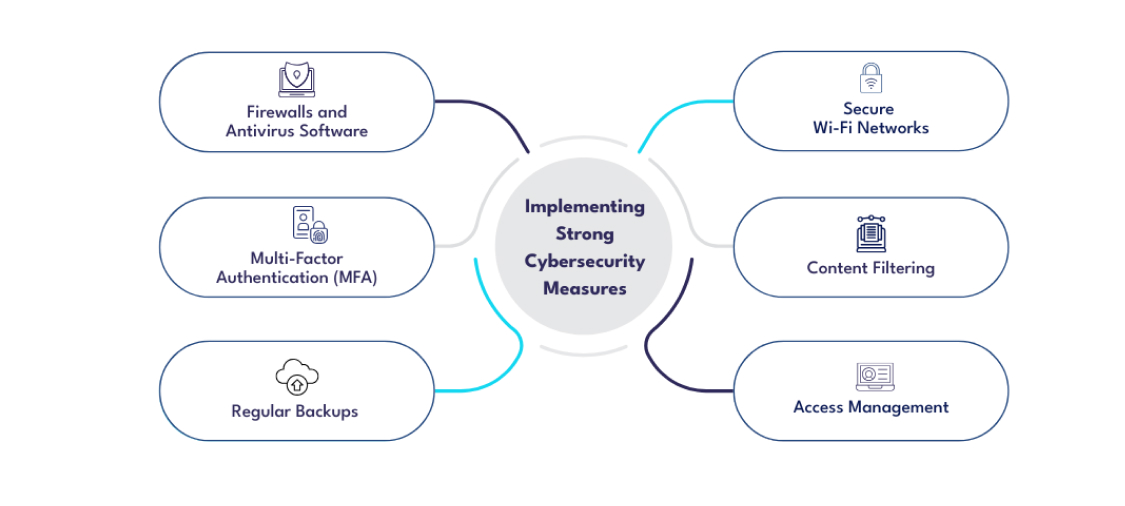
- Firewalls and Antivirus Software: These are the first lines of defense, blocking malware, ransomware, and unauthorized access attempts. Regular updates to these tools are necessary to respond to new threats.
- Multi-Factor Authentication (MFA): MFA adds another layer of verification, such as a one-time code or biometric scan, making it much harder for attackers to breach accounts.
- Regular Backups: Frequent backups of data stored in secure, offsite locations allow institutions to recover quickly from ransomware attacks, data corruption, or technical failures.
- Secure Wi-Fi Networks: Segregating administrative networks from student access and using strong encryption reduces the risk of internal breaches.
- Content Filtering: Filtering systems restrict access to non-educational or malicious websites, decreasing distraction and exposure to inappropriate content.
- Access Management: Establishing user roles with limited access based on responsibilities helps contain threats and prevent accidental data exposure.
Challenges of Cybersecurity
Despite best efforts, educational institutions face several challenges in building strong cybersecurity. Addressing these challenges requires thoughtful planning, clear communication, and ongoing adaptation to new technologies and threats.
Few of which are:
- Limited Budgets: Many institutions operate under tight financial constraints that make it difficult to invest in premium cybersecurity solutions or hire specialized personnel.
- Lack of Awareness: Cybersecurity is often viewed as a technical issue, not a shared responsibility. Without awareness, risky behaviors such as password sharing or clicking unknown links persist.
- Rapid Tech Adoption: The rush to integrate new learning technologies can outpace the development of accompanying security policies and risk assessments.
- Third-Party Risks: Educational tools and apps developed by external vendors may not meet the institution’s security standards, creating vulnerabilities.
- Balancing Access and Safety: Academic institutions aim to create open and collaborative environments. Finding the right balance between security and user freedom remains a complex task.
The Future of Cybersecurity in Education
As educational technology continues to evolve, the future of cybersecurity in these organizations will depend on proactive strategies and smarter systems. Emerging trends indicate a growing emphasis on predictive analytics, decentralized networks, and cybersecurity as a fundamental part of curriculum design.
In the future, more educational institutions may adopt AI-driven systems that can anticipate threats and respond automatically. There will likely be broader use of biometric authentication, such as facial recognition or fingerprint scanning, to enhance user security without compromising convenience. Educational centers may also rely on blockchain technology for data storage, ensuring greater transparency and reducing the risk of data tampering.
Cybersecurity will become more integrated with everyday teaching. Digital citizenship, cyber ethics, and online safety practices will be taught as essential life skills. Rather than being an add-on responsibility of the IT department, cybersecurity will be embedded across policies, platforms, and learning experiences.
Governments and education authorities may implement stricter guidelines and support systems to ensure institutions meet minimum security standards. The future calls for collaboration between educators, cybersecurity professionals, and technology developers to build secure digital learning ecosystems.
Conclusion
Cybersecurity in education is a shared responsibility that involves students, teachers, administrators, and technology providers. As digital learning continues to grow, the need to protect classroom environments becomes even more critical. By investing in secure infrastructure, promoting awareness, and embracing intelligent solutions like AI, institutions can create safer spaces for learning.
Digital classrooms should be places of exploration and creativity—not vulnerability. With the right practices, training, and technologies in place, educational institutions can safeguard their data, protect student identities, and ensure a smooth, uninterrupted learning experience for all.
Latest
Trends blogs
- Education and Industry Alignment: Rethinking Skill-Based Curriculum
- Education Policy Reform Amid Global Challenges and Shifting Standards
- Certification and Credentials: The New Fuel for Career Growth
- Technology in Outcome-Based Education: Driving Change in Higher Education


